This weekend’s momentous events cry-out for a reformulation of Earnest Hemingway’s famous five word quip in “The Sun Also Rises”.
Per his description of the route to bankruptcy: How did the dismal Afghan outpost of Washington’s Potemkin Empire collapse?
“Two ways. Gradually, then suddenly.”
Less than three months ago, Afghanistan’s puppet President, Ashraf Ghani, inadvertently crystalized 20-years worth of lies, delusions, misdirection and malfeasance by Imperial Washington’s policy-makers and proconsuls in response to a question from the press:
Q: How long can your government last without US support?
A: Forever.
Yet by midday Sunday Ghani had fled the presidential palace with four cars and so many pallets of greenbacks that they could not all be stuffed into his helicopter. And, of a sudden, there was nothing left of the Empire’s $2 trillion folly to bring peace, democracy, Coca-Cola, long pants and coed schools to this godforsaken expanse of the Hindu Kush.
Then again, it wasn’t just Ghani. Just a few weeks ago, Sleepy Joe was no less sanguine about the future than the Afghan president:
REPORTER: Is a Taliban takeover of Afghanistan now inevitable?
THE PRESIDENT: No, it is not.
REPORTER: Why?
THE PRESIDENT: Because you – the Afghan troops have 300,000 well-equipped – as well-equipped as any army in the world – and an air force against something like 75,000 Taliban. It is not inevitable.
Of course, Biden was undoubtedly assured of this salutary situation by Gen. Mark Milley. The latter is the most incompetent four-star to ever serve as chairman of the Joint Chiefs of Staff, a distinction for which he had plenty of competition. Yet with the Taliban already overtaking much of the country he assured as recently as July 21 that –
“The Afghan Security Forces have the capacity to sufficiently fight and defend their country…”
Then there was also the US intelligence agencies, which must have been channeling Hemingway’s very words. Just 4 days ago they estimated that Kabul could fall in 90 days and then suddenly revised the figure to 72 hours.
But nothing could top the blinky Washington careerist who now sits in the big chair at Foggy Bottom:
“If there is a significant deterioration in security … I don’t think it’s going to be something that happens from a Friday to a Monday.”
– Anthony Blinken, US secretary of state.
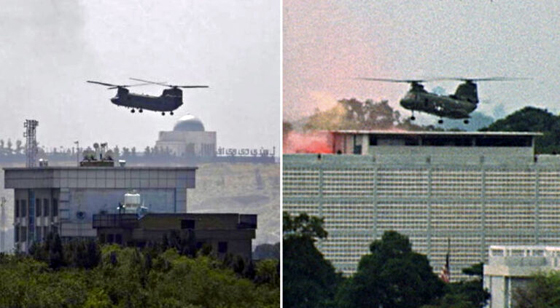
Left: The Fall of Kabul, 2021 – Right: The Fall of Saigon, 1975
Alas, it surely did. And now the same medieval brutes who were originally recruited and trained by the CIA in the 1980s and who ruled Afghanistan with a bloody reign of terror from 1996-2001, in fact, were in the president’s office within hours of Ghani’s flight. Except during the interim, the Grim Reaper of War had racked-up a horrendous butchers bill:
An October 2019 reckoning tabulated that 157,000 had been killed in the war in Afghanistan since 2001, including –
- Afghan security forces: 64,124;
- Afghan civilians: 43,074;
- Taliban fighters and other insurgents: 42,100:
- U.S. contractors: 3,814;
- US military personnel: 2,300:
- NATO and coalition troops: 1,145;
- Humanitarian aid workers: 424;
- Journalists and media: 67
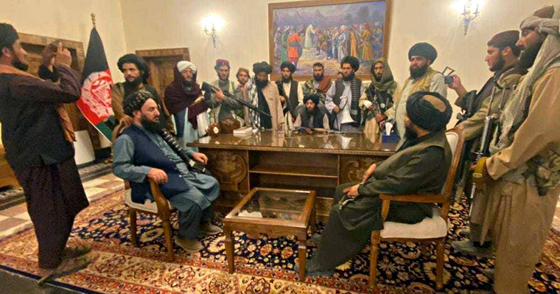
Taliban fighters take control of Afghan presidential palace in Kabul on Sunday. © AP
There is no mincing words about it. All the blood, treasure, political capital and moral authority expended by Washington in the prosecution of the the longest war in American history was completely in vain. Full stop.
There is absolutely nothing redeeming about it. Well, except that next time Washington announces a jolly little war in some no count corner of the planet – it is to be devoutly hoped that no one will come, allies will flee and the potential beneficiaries of occupation will scream at the top of their lungs, “no mas!”
As to the facts on the ground and their significance, the great Doug Bandow summarized as well as can be done:
The speed of collapse was shocking: the Afghan government possessed a larger military, better equipment, training and organization, an air force with command of the skies, and popular support, to the extent that such sentiment could be measured. Even many Afghan skeptics like me were surprised to see provincial capitals falling like bowling pins, with security forces surrendering en masse, sometimes without firing a shot. Desperate measures trotted out just a few days ago – such as reviving old ethnic militias and warlord armies – vanished as the Taliban advanced. Suddenly Kabul was surrounded, with surrender its only realistic option. Such is what the endless war crowd managed to achieve with 20 years, thousands of lives, and trillions of dollars.
In this regard, the map below is not just remarkable. It is a red hot smoking gun indictment of Washington’s War Party – proof that it delivered exactly nothing.
At least, nothing the Afghan people believed was worth defending. That’s because what this 37-day transformation of the map shows is that the 300,000 man Afghan National Army and the tens of thousands more domestic police forces stood up by Washington consisted of little more than sunshine mercenaries – -locals collecting their paychecks as usual in a tortured land of warlords, of which Washington was the latest, largest and most amply funded.
So when Sleepy Joe finally said what had to be said – that after 20 years we’re done – -the mercenaries and ghost battalions dropped their uniforms like a hot potato and faded into the towns, villages and mountain redoubts even faster than the South Vietnamese army had done in 1975.
After all, how do you go from 141 to 12 “government controlled” districts in a mere five weeks unless it’s because said government has deserted en mass?
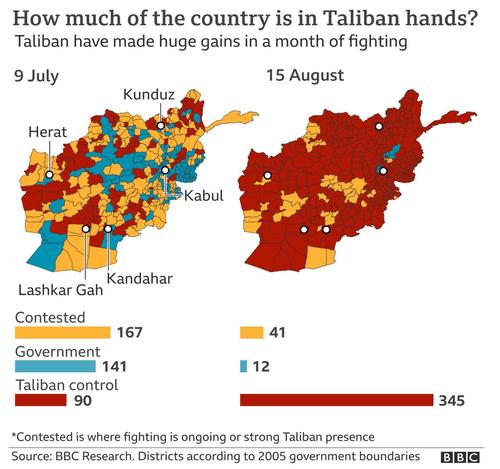
Not surprisingly, the bloodthirsty flotsam and jetsam of the Washington War Party is already at it – leveling the same silly charges of capitulation and betrayal at Biden as they did at Trump when he tried to withdraw from Syria and Obama when he properly brought American forces home from Iraq in 2011.
But as Doug Bandow also observed, the only real alternatives were to leave or stay forever:
Which was no choice at all. There is no justification for America to be allied to a political corpse, sucked dry by a corrupt and incompetent governing class, forced to fight on behalf of those who won’t defend themselves, entangled in combat in a region of little geopolitical importance to America, and tasked with maintaining regional stability for US rivals Russia and China.
As Bandow also reminds, the longest war in American history had no plausible rationale from the very beginning. Washington did not intervene because Central Asia had strategic relevance to America’s security. Even the eager interventionists back in 2001 did not claim that the essential purpose was to spread democracy, end discrimination against women or to to redress human rights violations.
No, the attack on Afghanistan originated in Washington’s foolish recruitment, training, arming and financing of the Mujahdeen back in the 1980s, and for exactly what purpose? To punish the sclerotic Soviet regime for stumbling into the Graveyard of Empires!
As Bandow further observed, the brutal misanthropes who became the Taliban were actually Washington’s own spawn – creatures of the CIA bank-rollers, Charlie Wilson’s War and all.
To the contrary, years earlier Washington supported the Mujahedeen, who were mostly undemocratic, misogynistic, intolerant, antediluvian, and brutal, to kill Soviet soldiers and undermine the Evil Empire, as Ronald Reagan termed the Soviet Union. After the latter’s withdrawal there was no reason for Washington to stick around.
After the 9/11 terrorist attacks the Bush administration sought to destroy al-Qaeda for its attack and punish the Taliban allegedly for hosting al-Qaeda. But as our friend Bill Bonner cogently reminds,
Just to remind ourselves, after 9/11, the US insisted Afghanistan turn over al-Qaeda leader Osama bin Laden. The Taliban, then Afghanistan’s rulers, said they would turn him over if the US produced evidence that he was guilty of masterminding the 9/11 attacks.
Otherwise, they said, it would be an insult to Islamic justice.
The Taliban even suggested a compromise – they would give bin Laden to a third country, where he might get a fair trial.
Nope. The frightful crew of neocon warmongers around Bush the Younger convinced him that a few strategically targeted bunker busters would so rattle the motley Toyota pickup based Taliban army that there would be no need for a deal.
In any event, we now know that Bin Laden and his small band of Arab fighters fled Afghanistan via their custom built escape routes to the Pakistan border almost immediately after their nearly fatal encounters with the US Air Force and a small group of special forces at Tora Bora in December 2001. After that, there was no reason to drop a single bomb on Afghanistan.
The fact is, as reprehensible and medieval as they may have been, and presumably still are, the Taliban never threatened to attack America, did not have an expansionist agenda and could not have carried one out in a million years from the backs of their Toyota pickups, anyway. And if brutalization of their own people is a valid basis for Washington’s intervention, the only case you can make for its war on Afghanistan is that the latter starts with an “A” and is presumably just the first on this list of dozens and dozens of such regimes that dot the planet.
As for the canard that the occupation of Afghanistan was necessary to deprive terrorists of a base, you have to marvel at what passes for thinking in the Imperial City. The planet is festooned with hell holes which can provide sanctuary to evildoers, but the irony is that the US Air Force has left nothing to chance: The destroyed cities and towns rippling with human misery and economic want that were continuously fostered by its lethal ministrations for years in Syria, Iraq, Yemen, Libya etc. provided all the sanctuary and all the motivations of revenge that real terrorists could have possibly dreamed of.
Moreover, Washington’s unforgivable sin wasn’t just the upwards of $1.2 trillion spent directly prosecuting a pointless war over the course of two decades. Or the fact that it resulted in more than 775,000 US troops being deployed to Afghanistan, many of them multiple times – 2,300 of whom died there and 20,589 of whom were wounded in action and remain wards of the state to this day.
No, Washington also allocated more than $133 billion to so-called nation-building efforts. And that’s more than it spent, adjusted for inflation, to revive the whole of Western Europe with the Marshall Plan after World War II!
Yet as one acerbic critic noted,
Washington officials tried to create – from scratch – a democratic government in Kabul modeled after their own in Washington. It was a foreign concept to the Afghans, who were accustomed to tribalism, monarchism, communism and Islamic law.
In this regard, in December 2019 the Washington Post published “The Afghanistan Papers: A Secret History of the War”. It was based on extensive reports by the Office of the Special Inspector General for Afghanistan Reconstruction (SIGAR), an agency created by Congress in 2008 to investigate waste and fraud in the war zone. These reports and the Washington Post investigation document in chapter and verse the unspeakable corruption and waste which dogged every aspect of this two decade long disaster.
One unidentified contractor, for instance, told government interviewers he was expected to dole out $3 million daily for projects in a single Afghan district roughly the size of a US county. He once asked a visiting congressman whether the lawmaker could responsibly spend that kind of money back home:
He said hell no. “Well, sir, that’s what you just obligated us to spend and I’m doing it for communities that live in mud huts with no windows.”
Year after year, US generals have said in public they are making steady progress on the central plank of their strategy, which was to train a robust Afghan army and national police force that could defend the country without foreign help.
In the Lessons Learned interviews, however, US military trainers described the Afghan security forces as incompetent, unmotivated and rife with deserters. They also accused Afghan commanders of pocketing salaries – paid by US taxpayers – for tens of thousands of “ghost soldiers.”
A US military officer estimated that one-third of police recruits were “drug addicts or Taliban”. Yet another called them “stealing fools” who looted so much fuel from US bases that they perpetually smelled of gasoline.
And it’s not as if this kind of knowledge remained bottled up in the Afghan mountains. In fact, Douglas Lute, a three-star Army general who served as the White House’s Afghan war czar during the Bush and Obama administrations, told government interviewers in 2015:
We were devoid of a fundamental understanding of Afghanistan – we didn’t know what we were doing….What are we trying to do here? We didn’t have the foggiest notion of what we were undertaking.
Likewise, another military investigator, Bob Crowley, an Army colonel who served as a senior counterinsurgency adviser to US military commanders in 2013 and 2014, told government interviewers.
Surveys, for instance, were totally unreliable but reinforced that everything we were doing was right and we became a self-licking ice cream cone.
Pictured below are the Four Stooges – General David Petraeus, General Mike Mullen, former General and VA head Eric Shinseki and Defense Secy Robert Gates – who advised Obama back in 2009 that a “surge” of forces in Afghanistan would be just as successful (sic!) as it had been in Iraq.
Of course, you could multiply these four by countless more before and since. Yet you would likely find that about the only high level official who ever told the truth out loud about the ongoing Afghan fiasco, General Michael Flynn, so thoroughly earned the contempt of the Imperial City that they had him bound and quartered and run out of town on a rail to the big house within weeks of being appointed as the Donald’s top national security advisor.
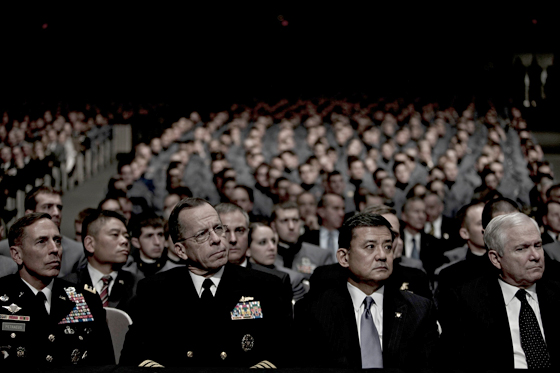
Of course, the results were always the same. The internal violence never stopped and the territory, which was never a nation but only a battleground for a changing mix of ethnic factions and tribal warlords, remained mired in chaos. The outcome during the first six months this year, in fact, was par for the course that had held sway ever since the Afghan Surge came a cropper a decade ago.
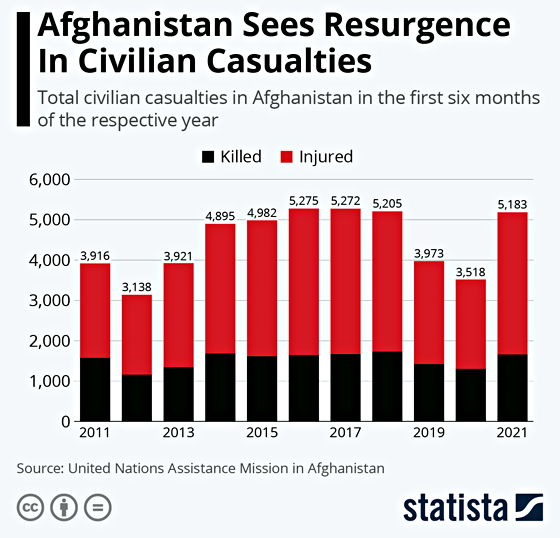
Needless to say, the Afghanistan fiasco is not an aberration – some kind of star-crossed one-off which unfolded far away from the mainstream of US foreign policy. To the contrary, Afghanistan is the distilled essence of Imperial Washington’s conceit that the peace of the planet depends upon its self-conferred role as the “indispensable nation” and the overseer of the internal governance and the external relations of the greater part of mankind.
Pursuant to this conceit, Washington foolishly believed that after uprooting the Taliban rulers in 2001 that it could will into being a national unity government. A simulacrum of the latter, in fact, was anointed from among the anti-Taliban tribes, factions, warlords, soldiers of fortune, thieves and opportunists who gathered at the Hotel Petersberg in Bonn Germany during December 2001.
But that dubious gathering surely guaranteed the fiasco which ensured, culminating in this weekend’s resounding rebuke of Washington’s imperial pretensions.
The thing is, Afghanistan never was a real nation, and there was not a snowballs’ chance in the hot place that Washington’s suits and uniforms, bedecked with limitless greenbacks and weapons of terror, could ever organize a functioning country there, let along a peaceful democracy.
Indeed, the region’s serpentine ethnic and tribal stew was well described it in a study published by the Norwegian Ministry of Foreign Affairs. Even a few excerpts from the study tell you all you need to know as why nation-building in the Hindu Kush was one the most absurd missions ever undertaken by Washington’s interventionist apparatchiks.
Like in the case of the misbegotten Sikes-Picot boundaries drawn in 1916 to create European style polities of Lebanon, Syria and Iraq, where no such nations actually existed, the borders of modern Afghanistan reflect the dead hand of the British foreign office from the 1890s.
Afghanistan’s national anthem recognizes 14 ethnic groups among the country’s 27 million people: Pashtuns, Tajiks, Hazaras, Uzbeks, Balochis, Turkmens, Nooristanis, Pamiris, Arabs, Gujars, Brahuis, Qizilbash, Aimaq and Pashai. Few groups are indigenous to Afghanistan; most of the larger ones have significantly greater populations in neighboring countries. Governing a viable state with these demographics has always been a core challenge.
Today’s group relations and aspirations were shaped and greatly influenced during the emergence of modern Afghanistan during the reign of Amir Abdul Rahman (1880-1901). The Pashtuns lost their overwhelming majority at that time, because the Amir ceded the majority Pashtun population and their territories to British India, under the Durand Line treaty agreement of 1893. But his consolidation of a centralized state, pacification of the Hazarajat and resettlement of the Pashtuns into ethnically mixed northern regions established Pashtun domination in Afghanistan. Still, it was (non-Pashtun) Dari–speakers, Tajiks and Qizilbash in particular, who practically ran the administration through domination of the bureaucracy……
The relative political freedoms granted under the 1964 Constitution allowed the formation of leftist and Islamist groups. At the same time, ethnicity played a more prominent role in political alignments. Setam-e Milli (National Oppression) emerged as decidedly anti-Pashtun organization whose focus was the overthrow what they described as the Pashtun dominance of Afghanistan. On the other hand, Afghan Millat, a Pashtun nationalist political party, advocated greater Pashtunization of Afghanistan and even aspired to unite all Pashtuns. Many leaders of the two major factions of the (communist) Peoples Democratic Party of Afghanistan (PDPA) also supported such views.
The April 27, 1978 communist military coup, called the Saur Revolution by its instigators, marked the end of Durrani dynasty and opened the political arena to all aspirants. The Pashtun-dominated Khalq faction attempted to break down the dominance of Dari by focusing on language and cultural policy. The regime recognized Uzbeki, Turkmeni, Balochi and Nooristani as official languages and promoted Pashtun culture.
But such policies were reversed to the advantage of non-Pashtun groups after the December 1979 Soviet invasion, which brought the Parcham faction into power. During the reign of Parcham leader Babrak Karmal, Dari was promoted at the expense of Pashto as his regime increased the non-Pashtun representation within the military and the bureaucracy. Ethnicity also emerged as a factor of unity and division among the armed Islamist opposition to the regime. In Pakistan, Pashtun Islamists firmly controlled the resistance leadership while Iran supported the pre-dominantly Hazara Shi’a groups. In that atmosphere of internal fragmentation and external interference, President Najibullah’s efforts at intra-Afghan reconciliation failed.
Najibullah’s downfall heralded the beginning of a messy civil war and the complete dismantling of Afghan state institutions. An alliance of non-Pashtun Parchami officials with the Tajik leader Ahmad Shah Massoud ensured the demise of his regime, which was considerably weakened by the defection of Pashtun military officers after the Soviet army withdrew in early 1989. The Pashtuns lost influence and suffered perhaps the sharpest decline in their influence in this period.
Still, the Afghan state’s demise proved disastrous for all Afghan civilians irrespective of their ethnicity and political affiliation. The mujahedin regime was a mirage consisting of shifting alliances and conspiracies. While it claimed to be the protector of its members’ various ethnicities, the leaders were amenable to external pressures and battlefield compulsions. Their struggle ultimately centered on individual survival and power grabs while often using ethnicity as a convenient cover and a powerful mobilizing tool. Their main achievement until the emergence of the Taliban in late 1994 was to plunge Afghanistan deep into civil war and anarchy.
The Taliban raison d’être was to end the anarchy. But when they took on powerful non-Pashtun warlords and militias, some Afghan and international observers tended to describe them as “Pashtun nationalists” who wanted to revive a centralized Pashtun-dominated state in Afghanistan. In fact, one of the first Taliban acts after capturing Kabul in September 1996 was to kill Najibullah and hang his corpse on public display.
However, the Taliban failed to please any segment of Afghan society after capturing Kabul in September 1996. Their rigid policies never won them overwhelming public support among the Pashtuns. The Taliban were opposed to all Pashtun political elites in the regimes preceding them. They opposed the nationalist mainstream of the old royalist regime and, unlike the communists, had no worldly focus on material development as a means of radical progress.
Many Pashtun mujahedin commanders fought against the Taliban for years. In fact, many Kandahari mujahedin joined Herati Tajik (sometime he is also identified as Farsiwan) warlord, Ismail Khan, to fight the Taliban. Senior Pashtun commanders from southern and eastern Afghanistan allied themselves with Ahmed Shah Massoud during the Taliban’s stint in power. Many Pashtun mujahedin commanders retained their status only by joining the Taliban.
Although the majority of the Taliban came from the southern Pashtun tribal confederacies of the Ghilzai and the Durrani, engaging in traditional tribal politics remained anathema to them. Many Taliban networks were organized on the notion of andewali (Pashto for friendship) and some of these networks manifested tribal solidarity. While they were seen as adhering to Pashtunwali by outsider observers, the Taliban opposed important aspects of local narkhs, or customary law, in various Pashtun regions. Their central objectives, to which they strongly adhered, were to implement Islamic Shari’ah law and bring their own vision of peace to Afghanistan.
At the dawn of 21st century, the conflict in Afghanistan was seen above all as an ethnic struggle. Pakistan and Saudi Arabia were seen as bankrolling a Pashtun takeover of the country by supporting the Taliban. On the other hand, Iran, Russia, some Central Asian states and India supported the essentially non-Pashtun Northern Alliance, to prevent a complete Taliban victory when the fundamentalist militia already controlled more than 90 percent of Afghanistan’s territory.
Afghanistan attracted unprecedented international attention after the September 11, 2001 attacks in New York and Washington. A swift American–led military victory routed the Taliban and a much slower – and flawed – political intervention focused on delivering a “broad-based and multi-ethnic” government. Hamid Karzai, a Durrani Pashtun leader from Kandahar, was picked to lead the first transitional administration.
The 30-member cabinet he led included 11 Pashtuns, 8 Tajiks, 5 Hazaras, 3 Uzbeks and 3 members of other ethnic minorities. The Taliban were then considered to be a spent force and were not even invited to the UN-brokered meeting in Bonn Germany, which delivered the interim administration and a roadmap for the country’s political reconstruction. The key flaw in the arrangement was that it prioritized the resolution of the ethnicized Afghan conflict. In reality, that ethnicization did not filter down to the masses.
Most, if not all, Afghans simply wanted security, good governance, basic services and transitional justice. However, the provision of these fundamental demands was relegated to secondary significance.
Alas, they still do.
However, far be it from the purported party of small government and a constitutional Republic, aka the GOP, to recognize the futility, illegality and costly malefactions of Washington’s failed adventure in the godforsaken redoubts of the Hindu Kush.
Here is just a sample of what these meatheads had to say over the weekend, and the proof that the only thing possibly stupider than Imperial Washington is its Republican branch:
This is President Biden’s Saigon moment,” House Minority Whip Steve Scalise (R-La.) said on CBS’s “Face the Nation.”
Biden is “gonna have blood on his hands” over the withdrawal of U.S. troops and subsequent swift takeover by the Taliban……They totally blew this one. They completely underestimated the strength of the Taliban,” said McCaul, the top-ranking Republican on the House Foreign Affairs Committee.
Nebraska Sen. Ben Sasse (R) lambasted the “Trump-Biden doctrine of weakness” that he said had been created by the foreign policies of both administrations, which he said “deliberately decided to lose” the conflict in Afghanistan.
But it was the present day face of the warmongering Cheney Clan, Rep. Liz Cheney, who reminded that it is owing to Washington’s neocon contaminated bipartisan duopoly that something as outrageously grotesque as America’s 20-year oppression and near-genocide in Afghanistan could actually happen in a nation founded on the principle of commerce with all nations and interference in the internal affairs of none:
“……the Trump/Biden calamity unfolding in Afghanistan began with the Trump administration negotiating with terrorists and pretending they were partners for peace, and is ending with American surrender as Biden abandons the country to our terrorist enemies.”
“Surrender” in a country that did not request Washington’s intervention and for which there was not an iota of national safety and security at stake?
Indeed, in rebuke to Lynn Cheney’s hegemonic prattle, what better occasion to be reminded of the words of John Quincy Adams. They were issued nearly 200 years ago, but are as apt today as ever before:
What has America done for the benefit of mankind? Let our answer be this: America, with the same voice which spoke herself into existence as a nation, proclaimed to mankind the inextinguishable rights of human nature, and the only lawful foundations of government. America, in the assembly of nations, since her admission among them, has invariably, though often fruitlessly, held forth to them the hand of honest friendship, of equal freedom, of generous reciprocity.
She has uniformly spoken among them, though often to heedless and often to disdainful ears, the language of equal liberty, of equal justice, and of equal rights. She has, in the lapse of nearly half a century, without a single exception, respected the independence of other nations while asserting and maintaining her own.
She has abstained from interference in the concerns of others, even when conflict has been for principles to which she clings…..
Wherever the standard of freedom and Independence has been or shall be unfurled, there will her heart, her benedictions and her prayers be. But she goes not abroad, in search of monsters to destroy. She is the well-wisher to the freedom and independence of all. She is the champion and vindicator only of her own.
She will commend the general cause by the countenance of her voice, and the benignant sympathy of her example. She well knows that by once enlisting under other banners than her own, were they even the banners of foreign independence, she would involve herself beyond the power of extrication, in all the wars of interest and intrigue, of individual avarice, envy, and ambition, which assume the colors and usurp the standard of freedom. The fundamental maxims of her policy would insensibly change from liberty to force…. She might become the dictatress of the world. She would be no longer the ruler of her own spirit….
We leave the final epitaph to Bill Bonner, who has spent as many years observing Imperial Washington’s follies as has your editor, and to a more lyrical effect:
And then on Sunday, like the other great empires before it, it came to the end of the road.
The puppet government in Kabul, set up by the US government, fled on helicopters… an eerie reminder of the fall of Saigon in 1975.
Afghanistan is known as the “graveyard of empires.” And we doubt this episode will be an exception.
The British left Afghanistan in 1919, after 80 years of frustrating warfare. Less than 20 years later, the British empire was, essentially, finished.
The Soviet Union gave up trying to pacify Afghanistan in 1988; two years later, the Soviet Union collapsed.
And now, it’s America’s turn.
David Stockman was a two-term Congressman from Michigan. He was also the Director of the Office of Management and Budget under President Ronald Reagan. After leaving the White House, Stockman had a 20-year career on Wall Street. He’s the author of three books, The Triumph of Politics: Why the Reagan Revolution Failed, The Great Deformation: The Corruption of Capitalism in America and TRUMPED! A Nation on the Brink of Ruin… And How to Bring It Back. He also is founder of David Stockman’s Contra Corner and David Stockman’s Bubble Finance Trader.




